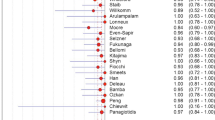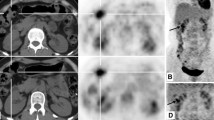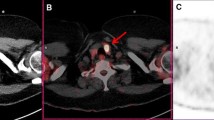Abstract
Introduction
We aimed to explore the role of the diagnostic accuracy of F-18 fluorodeoxyglucose positron emission tomography/computed tomography (PET/CT) for characterization of incidental colorectal focal FDG uptake through a systematic review and meta-analysis.
Methods
The MEDLINE, EMBASE, and Cochrane Library database, from the earliest available date of indexing through April 30, 2018, were searched for studies evaluating the diagnostic performance of F-18 FDG PET/CT for characterization of incidental colorectal focal FDG uptake. We determined the sensitivities and specificities across studies, calculated positive and negative likelihood ratios (LR+ and LR−), and constructed summary receiver operating characteristic curves.
Results
Across 8 studies (1451 patients), the pooled sensitivity for F-18 FDG PET/CT was 0.87 (95% CI 0.82–0.90) without heterogeneity (χ2 = 10.84, p = 0.37) and a pooled specificity of 0.83 (95% CI 0.76–0.89) with heterogeneity (χ2 = 130.1, p = 0.00). Likelihood ratio (LR) syntheses gave an overall positive likelihood ratio (LR+) of 5.2 (95% CI 3.6–7.4) and negative likelihood ratio (LR−) of 0.16 (95% CI 0.12–0.22). The pooled DOR was 32 (95% CI 20–51).
Conclusion
F-18 FDG PET/CT demonstrated good sensitivity and specificity for characterization of incidental colorectal focal FDG uptake. At present, the literature regarding the use of F-18 FDG PET/CT for characterization of incidental colorectal focal FDG uptake remains still limited; thus, further large multicenter studies would be necessary to substantiate the diagnostic accuracy of F-18 FDG PET/CT for characterization of incidental colorectal focal FDG uptake.





Similar content being viewed by others
References
Siegel RL, Miller KD, Jemal A (2017) Cancer statistics, 2017. CA Cancer J Clin 67:7–30
Leslie A, Carey FA, Pratt NR, Steele RJ (2002) The colorectal adenoma-carcinoma sequence. Br J Surg 89:845–860
Atkin WS, Saunders BP (2002) Surveillance guidelines after removal of colorectal adenomatous polyps. Gut 51(Suppl V):V6–V9
Blodgett TM, Meltzer CC, Townsend DW (2007) PET/CT: form and function. Radiology 242:360–385
Czernin J, Allen-Auerbach M, Schelbert HR (2007) Improvements in cancer staging with PET/CT: literature-based evidence as of September 2006. J Nucl Med 48:78–88
Bar-Shalom R, Yefremov N, Guralnik L, et al. (2003) Clinical performance of PET/CT in evaluation of cancer: additional value for diagnostic imaging and patient management. J Nucl Med 44:1200–1209
Lonneux M (2008) FDG-PET and PET/CT in colorectal cancer. PET Clin 3:147–153
Kantorová I, Lipská L, Bêlohlávek O, et al. (2003) Routine 18F-FDG PET preoperative staging of colorectal cancer: comparison with conventional staging and its impact on treatment decision making. J Nucl Med 44:1784–1788
Israel O, Yefremov N, Bar-Shalom R, et al. (2005) PET/CT detection of unexpected gastrointestinal foci of 18F-FDG uptake: incidence, localization patterns, and clinical significance. J Nucl Med 46:758–762
Jadvar H, Schambye RB, Segall GM (1999) Effect of atropine and sincalide on the intestinal uptake of F-18 fluorodeoxyglucose. Clin Nucl Med 24:965–967
Abdel-Nabi H, Doerr RJ, Lamonica DM, et al. (1998) Staging of primary colorectal carcinomas with fluorine-18 fluorodeoxyglucose whole-body PET: correlation with histopathologic and CT findings. Radiology 206:755–760
Meyer MA (1995) Diffusely increased colonic F-18 FDG uptake in acute enterocolitis. Clin Nucl Med 20:434–435
Weston BR, Iyer RB, Qiao W, et al. (2010) Ability of integrated positron emission and computed tomography to detect significant colonic pathology: the experience of a tertiary cancer center. Cancer 116:1454–1461
Kei PL, Vikram R, Yeung HW, Stroehlein JR, Macapinlac HA (2010) Incidental finding of focal FDG uptake in the bowel during PET/CT: CT features and correlation with histopathologic results. AJR 194:W401–W406
Oh JR, Min JJ, Song HC, et al. (2012) A stepwise approach using metabolic volume and SUVmax to differentiate malignancy and dysplasia from benign colonic uptakes on 18F-FDG PET/CT. Clin Nucl Med 37:e134–e140
Shie P (2011) Incidental focal hypermetabolic colorectal lesions identified by positron emission tomography: prevalence of malignancy. Abdom Imaging 36:165–169
Luboldt W, Volker T, Wiedemann B, et al. (2010) Detection of relevant colonic neoplasms with PET/CT: promising accuracy with minimal CT dose and a standardised PET cut-off. Eur Radiol 20:2274–2285
Chen YK, Kao CH, Liao AC, Shen YY, Su CT (2003) Colorectal cancer screening in asymptomatic adults: the role of FDG PET scan. Anticancer Res 23:4357–4361
Tatlidil R, Jadvar H, Bading JR, Conti PS (2002) Incidental colonic fluorodeoxyglucose uptake: correlation with colonoscopic and histopathologic findings. Radiology 224:783–787
Lee ST, Tan T, Poon AM, et al. (2008) Role of low-dose, noncontrast computed tomography from integrated positron emission tomography/computed tomography in evaluating incidental 2-deoxy-2-[F-18]fluoro-d-glucose-avid colon lesions. Mol Imaging Biol 10:48–53
Kousgaard SJ, Thorlacius-Ussing O (2017) Incidental colorectal FDG uptake on PET/CT scan and lesions observed during subsequent colonoscopy: a systematic review. Tech Coloproctol 21:521–529
Treglia G, Taralli S, Salsano M, et al. (2014) Prevalence and malignancy risk of focal colorectal incidental uptake detected by 18F-FDG-PET or PET/CT: a meta-analysis. Radiol Oncol 48:99–104
Whiting PF, Rutjes AW, Westwood ME, et al. (2011) QUADAS-2: a revised tool for the quality assessment of diagnostic accuracy studies. Ann Intern Med 155:529–536
Glas AS, Lijmer JG, Prins MH, Bonsel GJ, Bossuyt PM (2003) The diagnostic odds ratio: a single indicator of test performance. J Clin Epidemiol 56:1129–1135
Thompson SG (1994) Why sources of heterogeneity in meta-analysis should be investigated. BMJ 309:1351–1355
Deeks JJ, Macaskill P, Irwig L (2005) The performance of tests of publication bias and other sample size effects in systematic reviews of diagnostic test accuracy was assessed. J Clin Epidemiol 58:882–893
Reitsma JB, Glas AS, Rutjes AW, et al. (2005) Bivariate analysis of sensitivity and specificity produces informative summary measures in diagnostic reviews. J Clin Epidemiol 58:982–990
Hamza TH, van Houwelingen HC, Stijnen T (2008) The binomial distribution of meta-analysis was preferred to model within-study variability. J Clin Epidemiol 61:41–51
Rutter CM, Gatsonis CA (2001) A hierarchical regression approach to meta-analysis of diagnostic test accuracy evaluations. Stat Med 20:2865–2884
Lijmer JG, Mol BW, Heisterkamp S, et al. (1999) Empirical evidence of design-related bias in studies of diagnostic tests. JAMA 282:1061–1066
Choi BW, Kim HW, Won KS, et al. (2016) Diagnostic accuracy of 18F-FDG PET/CT for detecting synchronous advanced colorectal neoplasia in patients with gastric cancer. Medicine 95:e4741
Soltau SR, Hess S, Nguyen T, et al. (2016) Clinical significance of incidental focal bowel uptake on 18F-FDG PET/CT as related to colorectal cancer. Hell J Nucl Med 19:245–249
van Hoeij FB, Keijsers RG, Loffeld BC, et al. (2015) Incidental colonic focal FDG uptake on PET/CT: can the maximum standardized uptake value (SUVmax) guide us in the timing of colonoscopy? Eur J Nucl Med Mol Imaging 42:66–71
Na SY, Kim KJ, Han S, et al. (2015) Who should undergo a colonoscopy among patients with incidental colon uptake on PET-CT? Scand J Gastroenterol 50:1045–1053
Cho SH, Kim SW, Kim WC, et al. (2013) Incidental focal colorectal 18F-fluorodeoxyglucose uptake on positron emission tomography/computed tomography. World J Gastroenterol 19:3453–3458
Liu T, Behr S, Khan S, Osterhoff R, Aparici CM (2015) Focal colonic FDG activity with PET/CT: guidelines for recommendation of colonoscopy. World J Nucl Med 14:25–30
Lee C, Koh SJ, Kim JW, et al. (2013) Incidental colonic 18F-fluorodeoxyglucose uptake: do we need colonoscopy for patients with focal uptake confined to the left-sided colon? Dig Dis Sci 58:229–235
Drenth JP, Nagengast FM, Oyen WJ (2001) Evaluation of (pre-) malignant colonic abnormalities: endoscopic validation of FDG-PET findings. Eur J Nucl Med 28:1766–1769
Engel H, Steinert H, Buck A, et al. (1996) Whole-body PET: physiological and artifactual fluorodeoxyglucose accumulations. J Nucl Med 37:441–446
Strauss LG (1996) Fluorine-18 deoxyglucose and false-positive results: a major problem in the diagnostics of oncological patients. Eur J Nucl Med 23:1409–1415
Even-Sapir E, Lerman H, Gutman M, et al. (2006) The presentation of malignant tumors and pre-malignant lesions incidentally found on PET-CT. Eur J Nucl Med Mol Imaging 33:541–552
Gutman F, Alberini JL, Wartski M, et al. (2005) Incidental colonic focal lesions detected by FDG PET/CT. Am J Roentgenol 185:495–500
Pandit-Taskar N, Schöder H, Gonen M, Larson SM, Yeung HW (2004) Clinical significance of unexplained abnormal focal FDG uptake in the abdomen during whole-body PET. AJR 183:1143–1147
Ozkol V, Alper E, Aydin N, et al. (2010) The clinical value of incidental 18F-fluorodeoxyglucose-avid foci detected on positron emission tomography/computed tomography. Nucl Med Commun 31:128–136
Acknowledgements
This work was supported by a 2-Year Research Grant of Pusan National University.
Author information
Authors and Affiliations
Corresponding author
Ethics declarations
Conflict of interest
The authors of this manuscript declare no relationships with any companies whose products or services may be related to the subject matter of the article.
Ethical approval
Institutional review board approval was not required because we only performed data analysis based on the published studies.
Informed consent
Written informed consent was not required for this study because it is a meta-analysis based on the studies that have been published.
Rights and permissions
About this article
Cite this article
Son, G.M., Kim, SJ. Diagnostic accuracy of F-18 FDG PET/CT for characterization of colorectal focal FDG uptake: a systematic review and meta-analysis. Abdom Radiol 44, 456–463 (2019). https://doi.org/10.1007/s00261-018-1747-1
Published:
Issue Date:
DOI: https://doi.org/10.1007/s00261-018-1747-1




